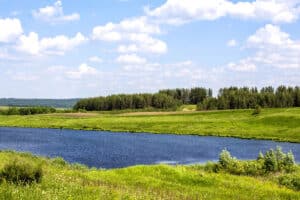So the story goes something like this… The young farm boy comes to his boss and asks, “So, what is old Mr. Henry’s farm worth?” The old farmer looks over at the young man, tips his hat back and says “well son, it all depends on whether you are buying or selling.”
The economics of this example translates easily in evaluating a land buyer’s willingness to pay for a given property. Not all land buyers share the same goals in terms of land use, return on investment or management. While this may seem readily obvious, it is often not well understood by practitioners in the industry; and these differences if identified can yield valuable indicators for determining land value that will be internalized in today’s land market. The “buyer values” I will outline are often captured in most appraisals, but it is understood that appraisals are a “snap shot in time” and do not often reflect the subtle motivations of buyers which drive them to make the purchase. Appraisals, just in the same way as this column, are a statement of opinion based on the best available information and analysis.
For the purpose of discussion, land buyers today can be characterized in the following classes: 1- Agricultural 2- Recreational 3- Investor. It is a dream to understand a client’s vision with such a clear lens of motivation and goals and typically the picture is not well defined, even by the buyer. This is my primary role in helping the buyer see what values they find most important in determining the overall value they are willing to pay. For each of these values there are a matrix of factors measured creating the bottom line evaluation by the buyer.
For the agricultural buyer value centers on productive farmland, often referred to as “tillable land”. Determining tillable acreage is fairly straightforward and is effectively measured and tallied each year at the local Soil and Water Conservation District Office. The tillable acreage has a wide array of value based on soil type to a farmer. Typically farmers are seeking land which is well drained but not too sandy so the land holds moisture well throughout the year. This is especially important in a year like we have been experiencing in which prolonged periods without rainfall can have devastating impacts to crop yields. Analyzing the soil type and its characteristics is critical to an agricultural buyer and is perhaps the most important factor in their decision. Additional factors considered might also include water resources available for irrigation, historic crop yields, history of farm with state and federal farm programs, access to the property and terms associated with existing agricultural lease. Location is also a significant factor to an agricultural buyer as they often have a footprint for their agribusiness and tend to work within the area they have defined for their operation.
While geography is critical to a farmer, the recreational buyer is much less concerned about location of the property around a given region and more on the location of users around the given tract of land they are considering. There are a myriad of recreational buyer uses but for my purpose here I will largely focus on the recreational buyer as a hunter. From their perspective, these values are influenced by what is going on around the property and how those uses influence the movement of wildlife and game in a given area. For instance, being a large agricultural operation between two public land holdings with limited hunting may be an advantage to the pattern Whitetail deer move through the open farmland as they move from protected areas. An even greater influence in this situation for the open agricultural operation is to offer much needed food for wintering wildlife that is often limited on unmanaged state or federal lands. In this situation the agricultural operation maximizes its location as to what activities are occurring around it and thus the value to a recreational buyer is much greater due to this fact. Factors also important to the recreational buyer include soil type, access to conservation programs, existing wildlife habitat, timber management, road infrastructure, and history of wildlife use for the area.
In contrast to both of these users is the investor. Values are based on sometimes short term upsides with 2 to 5 year development periods, as well as long term documented areas of growth where holding large land tracts will bring returns to the investor through land appreciation as economic activity spurs changes in land use. The key component to this type of value is realized through increasing the entitled development rights and approvals for the land tract. This work is often tedious, time consuming and financially burdensome. For those patient investors capitalized enough to add value to the property through development of the land, financial returns can be significant. Investment values in land are not easily predicted and require detailed analysis of zoning, soils, environmental regulations, subdivision regulations, building codes, utility infrastructure and other factors such as traffic studies which may play a role in garnering approvals from local planning and zoning offices. The entitlement process in recent years has grown in complexity and it is likely to increase in difficulty as additional zoning laws and regulations come on-line. These factors in addition to the demand for additional development make evaluating this aspect of value perhaps the most challenging.
Determining land value is clearly a function of perspective and knowledge of the array of issues that shape the broad spectrum of values internalized by the land market today. Land is a dynamic product and one that is not renewable on our timeline. In summary it is clearly important be mindful of land as a resource and understand the values you are seeking to realize in buying, selling, or managing land. I welcome the opportunity to assist you towards this goal in any way I can, or assist you in connecting with a professional within the group of land managers, surveyors, engineers, and land planners I am fortunate to work with.
This content may not be used or reproduced in any manner whatsoever, in part or in whole, without written permission of LANDTHINK. Use of this content without permission is a violation of federal copyright law. The articles, posts, comments, opinions and information provided by LANDTHINK are for informational and research purposes only and DOES NOT substitute or coincide with the advice of an attorney, accountant, real estate broker or any other licensed real estate professional. LANDTHINK strongly advises visitors and readers to seek their own professional guidance and advice related to buying, investing in or selling real estate.










Ben – very good article.
Here in the North Casroina mountains, we are encountering a buyer you did not mention – those seeking “getaway” locations – AKA “bug out locations” or “Prepper” locations.
The first buyer inquiries we began seeing just 3 weeks ago were somewhat subtle. They used words like “remote” and “end-of-the-road” in their descriptions. This increased in intensity with the most recent request for an “armageddon” property.
IS the sky falling? I doubt it, however this type of newcomer into the land market opens up some new doors – and obviously represents a different motivation than the ones you mentioned.
Anyone else out there seeing this happen?
Paul… I think this buyer in our market is typically about the waterfront…although how far away is my next neighbor is somewhat of a concern as well… that is somewhat difficult on the Eastern Shore as our density continues to increase and farm sizes decrease.
I think this buyer is very cautious at the moment still and I think they share qualities of the recreational buyer in that their purchase is not driven by returns on the investment for annual or near term strategies like an agribusiness buyer is…
Thanks for your comments… Cheers, Ben
Ben and Paul,
Here in the N GA mountains we are seeing a combination of what you guys are seeing. It is almost a daily request for “remote” or “end of the road” type properties and even more for the tracts that adjoin protected land or the tracts that have a large creek or river running through the property not just on the edge. Sellers of these gem type properties are seeing the same things the Buyers are seeing and know that their property is desireable. However, Buyers seem to have the thinking that they are the only ones looking for such type tracts and should be able to buy the property at a steep discount because it is “remote”
No matter where the property is located or what the purpose or intended use for the property the challege is finding the property buyer wants and at a price both the seller and buyer are willing sell/pay. That is why sellers just as much as buyers need to use a professional that has a focus on the type of property he or she is trying to sell or buy.
Ben that is a good article, and you are right on about the property being worth different amounts to different people. The seller in many cases can get an above-market price by dealing with the adjoining owner who wants to add to their land.
The truth is that the person who writes the appraisal does not write the checks, so although an appraisal shows one value the real buyer is the one that determines what it is worth to them.
Thanks for posting.